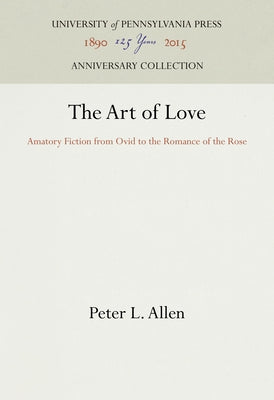Before you leave...
Take 20% off your first order
20% off
Enter the code below at checkout to get 20% off your first order
Discover summer reading lists for all ages & interests!
Find Your Next Read

Two major French medieval literary works that claim to teach their readers the art of love are virtually torn apart by the contradictions and conflicts they contain. In Andreas Capellanus's late twelfth-century Latin De amore, the author instructs his friend Walter in the amatory art in the first two books, but then harshly repudiates his own teachings and love itself in a third and final book. In Jean de Meun's encyclopedic continuation of the Romance of the Rose, written in French in the 1270s, a succession of allegorical figures alternately promote and excoriate the lover's amatory pursuits. Jean's romance, moreover, virtually rewrites the dream vision of Guillaume de Lorris, which it claims simply to extend, and ends with the depiction of a sexual act that seems to throw the book's whole structure into confusion.
The more closely one reads this works, Peter L. Allen contents, the harder it is to understand them: "Didactic, heavy-handed, and problematic, they teach would-be lovers how to behave in order to have others accomplish their desires, yet they also contain vociferous passages that dissuade their protagonists from the practice of this art, which, they claim, leads not only to earthly destruction but also to eternal damnation." Readers from the Middle Ages to the present have been troubled by the fact that these texts are both radically self-contradictory and fundamentally at odds with the accepted morality of medieval Christian Europe. And for decades, scholars have tried to determine how these two works are related to what is often referred to as "courtly love." In The Art of Love, Allen persuasive argues that the De amore and the Romance of the Rose are central to the courtly tradition. Allen contends that their conflicts and contradictions are not signs of confusion or artistic failure, but are instead essential clues which show that the medieval works follow the disruptive structural model of Ovid's first century elegiac Ars amatoria (Art of Love) and Remedia amoris (Cures for Love). Andreas's and Jean's works, no less than Ovid's, teach not the art of love for practicing lovers, but the literary art of love poetry and fiction. Based squarely on Ovid's poems, which were among the most widely read classical texts in medieval Europe, the De amore and the Romance of the Rose use the classical tradition in a particularly assertive fashion--and suggest a way for fantasies of love to exist even against a background of ecclesiastical prohibition.Thanks for subscribing!
This email has been registered!
Take 20% off your first order
Enter the code below at checkout to get 20% off your first order